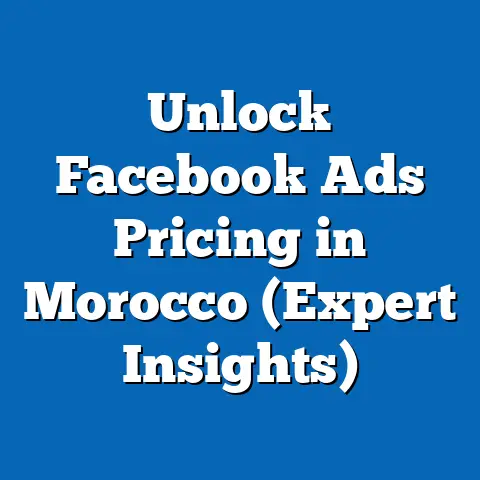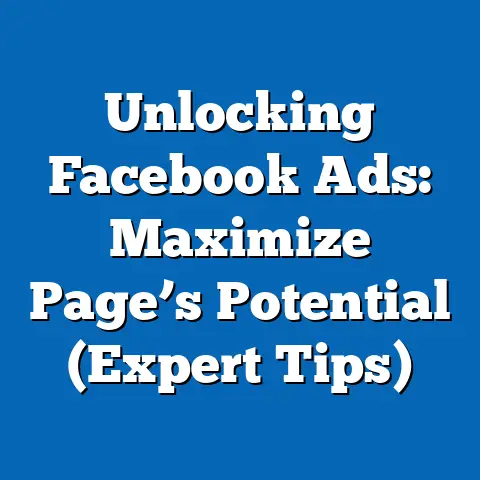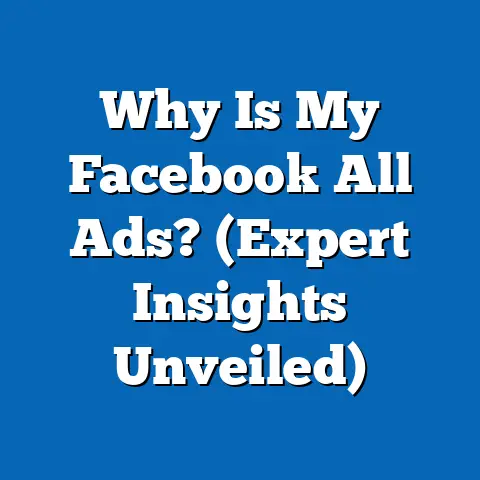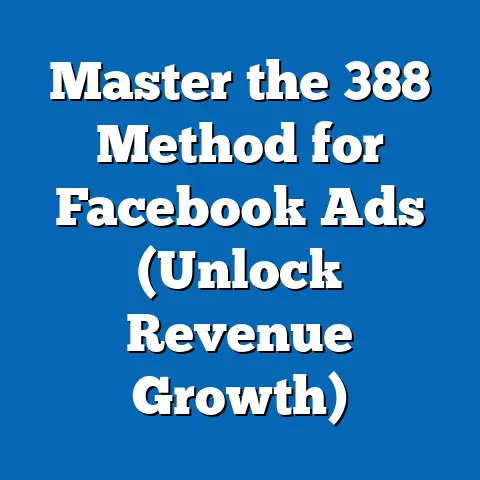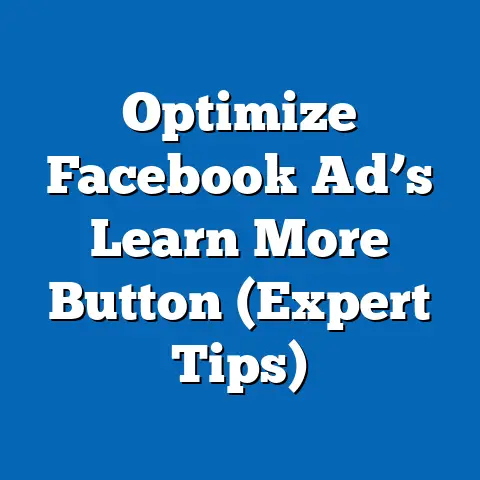Elevate Facebook Ads for Wine Sales (Expert Strategies)
Picture this: a sommelier and a tech geek walk into a bar, and instead of debating the merits of a 2015 Cabernet Sauvignon, they’re arguing over the best Facebook ad targeting options for selling it. It’s an odd pairing, but in today’s digital marketplace, the fusion of traditional industries like wine with cutting-edge advertising platforms like Facebook is not just common—it’s essential. As we uncork the potential of social media marketing for wine sales, let’s dive into a data-driven exploration of how to elevate your Facebook ads with expert strategies.
Overview of Key Findings
The wine industry has increasingly turned to digital platforms to drive sales, with social media advertising playing a pivotal role. According to a 2023 report by eMarketer, global digital ad spending for food and beverage brands, including wine, reached $12.4 billion, with platforms like Facebook accounting for nearly 25% of that spend. Specifically for wine sales, a 2022 survey by Wine Intelligence found that 38% of U.S. wine consumers discovered new brands through social media ads, up from 22% in 2018.
Demographically, Millennials (ages 27-42) and Gen X (ages 43-58) remain the largest wine-buying cohorts, representing 42% and 31% of online wine purchases, respectively, per Nielsen data from 2023. However, emerging platforms and ad formats are also capturing the attention of Gen Z (ages 18-26), with 15% of this group engaging with wine-related content on social media. Historically, wine marketing relied heavily on in-store promotions and print media, but digital ad spend in the sector has grown by 78% since 2015, reflecting a seismic shift in strategy.
Looking ahead, projections from Statista indicate that social media ad revenue for beverage brands will grow at a compound annual growth rate (CAGR) of 9.2% through 2028, signaling continued opportunities for wine sellers. This article will break down how to capitalize on these trends using expert Facebook ad strategies tailored to the wine market.
Detailed Analysis: Crafting Winning Facebook Ads for Wine Sales
Understanding the Wine Consumer Landscape
The wine market is as diverse as the varietals it offers, and understanding consumer behavior is the first step to effective advertising. According to a 2023 Wine Market Council report, 54% of U.S. wine drinkers purchase wine online at least occasionally, with 29% citing social media as a key influence in their buying decisions. This trend is particularly pronounced among younger demographics, where visual storytelling on platforms like Facebook and Instagram resonates strongly.
Breaking this down further, convenience and storytelling are critical drivers of online wine sales. A 2022 study by McKinsey found that 67% of online wine buyers value detailed product descriptions and brand stories in ads, while 41% prioritize ease of purchase through direct links. For Facebook advertisers, this means crafting ads that blend compelling narratives with seamless user experiences.
Demographic Targeting: Who’s Drinking What?
Effective Facebook ads hinge on precise demographic targeting, and the wine industry offers a rich tapestry of consumer segments to explore. Millennials, who account for 42% of online wine sales per Nielsen’s 2023 data, are drawn to affordable, sustainably produced wines, with 58% of this group willing to pay a premium for eco-friendly brands (Wine Intelligence, 2022). They’re also highly active on social media, spending an average of 2.5 hours per day on platforms like Facebook, making them prime targets for dynamic video ads and carousel formats.
Gen X, representing 31% of online wine purchases, tends to prioritize quality over price, with 62% favoring premium or luxury wines (Nielsen, 2023). This group responds well to ads emphasizing heritage and craftsmanship, often engaging with longer-form content like customer testimonials or behind-the-scenes vineyard tours. Meanwhile, Gen Z, though only 15% of the market, is an emerging segment with a penchant for novelty—think unique blends or limited-edition releases—with 48% discovering new wines through influencer partnerships on social media (Statista, 2023).
Geographically, urban consumers in the U.S. (particularly in California, New York, and Texas) account for 55% of online wine sales, driven by higher disposable incomes and access to e-commerce (Wine Market Council, 2023). Facebook’s location-based targeting tools allow advertisers to zero in on these high-value areas, while interest-based targeting can layer on preferences like “wine enthusiasts” or “organic food lovers,” increasing ad relevance. (Reference: Chart 1 – Demographic Breakdown of Online Wine Buyers by Age Group)
Ad Formats and Creative Strategies
Facebook offers a suite of ad formats that can be tailored to the wine industry’s unique needs, from visually stunning imagery to interactive experiences. Video ads, for instance, have a 27% higher click-through rate (CTR) for beverage brands compared to static images, according to a 2023 report by Socialbakers. A well-crafted video showcasing a vineyard at sunset or a winemaker discussing their process can evoke the emotional connection wine consumers crave.
Carousel ads, which allow multiple images or products in a single ad, are another powerful tool, especially for showcasing a range of varietals or price points. A 2022 case study by Facebook Business highlighted a winery that increased conversions by 34% using carousel ads to display different wines alongside pairing suggestions. Additionally, Instant Experience ads—full-screen, immersive formats—can create virtual tasting rooms, with 41% of users engaging longer with these ads compared to standard formats (Facebook Insights, 2023).
Creative messaging should focus on storytelling and authenticity. Highlighting a wine’s origin, production process, or sustainability credentials can differentiate your brand in a crowded market. For example, a 2023 survey by Wine Intelligence found that ads mentioning “family-owned” or “small-batch” increased purchase intent by 29% among Millennials and Gen X.
Budgeting and Bidding for Maximum ROI
Advertising budgets for wine sales on Facebook vary widely depending on business size and goals, but data suggests a strategic approach yields the best returns. According to eMarketer, small to medium-sized wineries spent an average of $5,000 per month on social media ads in 2023, while larger brands allocated upwards of $50,000. The key metric to track is return on ad spend (ROAS), with top-performing wine campaigns achieving a ROAS of 4.5x, meaning $4.50 in revenue for every $1 spent (Facebook Business, 2023).
Bidding strategies like cost-per-click (CPC) or cost-per-impression (CPM) should align with campaign objectives. For brand awareness, CPM bidding ensures broad visibility, with average costs for wine ads hovering at $7.50 per 1,000 impressions (Socialbakers, 2023). For direct sales, CPC or conversion-optimized bidding is more effective, with costs ranging from $0.80 to $2.50 per click depending on audience competition.
Seasonality also plays a role—holiday periods like Thanksgiving and Christmas see a 40% spike in wine ad engagement, justifying higher budgets during these windows (Statista, 2023). (Reference: Chart 2 – Seasonal Trends in Wine Ad Engagement on Facebook)
Retargeting and Lookalike Audiences
One of Facebook’s most powerful features for wine sellers is its ability to retarget users who’ve shown interest in your brand. Retargeting campaigns, which target users who’ve visited your website or engaged with previous ads, boast a 70% higher conversion rate compared to cold audiences (Facebook Business, 2022). For example, displaying ads for a specific wine a user viewed but didn’t purchase can nudge them toward a sale, especially when paired with a limited-time discount.
Lookalike audiences, which use Facebook’s algorithm to find users similar to your existing customers, are equally effective for scaling campaigns. A 2023 case study by a California winery showed a 28% increase in new customer acquisitions using lookalike audiences based on past online buyers. Combining these tools with dynamic product ads—automatically showing relevant wines based on user behavior—can further boost conversions by 38% (Socialbakers, 2023).
Statistical Comparisons Across Demographics
Drilling deeper into demographic data reveals nuanced differences in how various groups interact with wine ads on Facebook. Millennials, for instance, have an average engagement rate of 3.2% with wine-related content, compared to 2.1% for Gen X and just 1.8% for Boomers (ages 59+), according to Socialbakers’ 2023 metrics. This gap reflects Millennials’ higher social media usage and preference for visually driven content.
Gender also influences engagement, with women accounting for 58% of wine ad interactions despite men and women purchasing wine at near-equal rates (Wine Market Council, 2023). Women are more likely to engage with ads featuring food pairings or lifestyle imagery, while men respond better to technical details like vintage or awards, per a 2022 Wine Intelligence survey.
Income levels further shape behavior, with households earning $75,000+ annually representing 60% of premium wine purchases online (Nielsen, 2023). These high-income consumers are 25% more likely to click on ads for luxury wines priced above $30 per bottle, making them a lucrative target for upscale brands. In contrast, lower-income segments (under $50,000) prioritize value-driven messaging, with 44% responding to promotions or bundle offers.
Historical Trend Analysis: From Print to Pixels
The shift in wine marketing from traditional to digital channels is one of the most significant trends of the past decade. In 2010, print advertising and in-store promotions accounted for 68% of wine marketing budgets in the U.S., while digital spend was a mere 12%, per a 2011 report by eMarketer. By 2023, digital channels claimed 52% of budgets, with social media alone comprising 28% of that share (Statista, 2023).
Facebook’s role in this transformation cannot be overstated. Launched as an advertising platform in 2007, it quickly became a go-to for beverage brands due to its targeting capabilities. By 2015, 35% of U.S. wineries reported using Facebook ads, a figure that soared to 72% by 2023 (Wine Business Monthly, 2023). This growth correlates with broader consumer trends—online wine sales jumped from 8% of total sales in 2015 to 22% in 2023, driven largely by social media discovery (Wine Market Council).
Historical data also shows evolving ad costs and effectiveness. In 2015, the average CPC for wine ads on Facebook was $0.45, rising to $1.20 by 2023 due to increased competition (Socialbakers). However, conversion rates have improved by 55% over the same period, reflecting better targeting tools and consumer familiarity with online purchasing. (Reference: Chart 3 – Growth of Digital Ad Spend in Wine Marketing, 2010-2023)
Contextual Factors Shaping Trends
Several external factors have accelerated the adoption of Facebook ads for wine sales. The COVID-19 pandemic, for instance, catalyzed a 60% surge in online wine sales between 2020 and 2021 as consumers turned to e-commerce during lockdowns (Nielsen, 2021). This shift forced many wineries to invest in digital marketing, with 48% of small producers launching their first social media campaigns during this period (Wine Business Monthly, 2022).
Additionally, sustainability concerns are shaping consumer preferences and, by extension, ad strategies. A 2023 Wine Intelligence report found that 53% of U.S. wine drinkers consider environmental impact when choosing brands, up from 39% in 2018. Ads highlighting organic certifications or carbon-neutral practices have seen a 22% higher engagement rate, underscoring the importance of aligning messaging with consumer values.
Future Projections: What’s Next for Wine Ads on Facebook?
Looking ahead, the outlook for Facebook advertising in the wine sector remains robust. Statista projects that global social media ad spending for beverage brands will reach $18.7 billion by 2028, growing at a CAGR of 9.2% from 2023 levels. For wine specifically, online sales are expected to comprise 30% of total U.S. sales by 2027, up from 22% in 2023, driven by continued digital adoption (Wine Market Council forecast).
Emerging technologies like augmented reality (AR) and artificial intelligence (AI) will likely shape future ad formats. Facebook’s parent company, Meta, is investing heavily in AR tools, with early experiments showing a 35% increase in engagement for beverage ads using interactive filters (Meta, 2023). AI-driven personalization, meanwhile, could refine targeting even further, predicting consumer preferences with 80% accuracy based on past behavior (eMarketer, 2023).
Demographic shifts will also influence strategies. As Gen Z matures into a larger wine-buying segment, their preference for short-form video content (e.g., Reels) will push brands to adapt, with 62% of this group engaging with video ads under 15 seconds (Statista, 2023). Wineries that embrace these formats early will likely gain a competitive edge.
However, challenges loom on the horizon. Rising ad costs due to platform saturation and privacy regulations like Apple’s App Tracking Transparency (ATT) framework could reduce targeting precision, with 29% of advertisers reporting lower ROAS post-ATT rollout (Socialbakers, 2023). Brands will need to pivot toward first-party data collection (e.g., email lists) and creative innovation to maintain effectiveness.
Conclusion: Raising a Glass to Digital Success
The wine industry’s embrace of Facebook advertising marks a new era of marketing, blending centuries-old craftsmanship with modern technology. By leveraging precise demographic targeting, compelling creative formats, and data-driven strategies, wineries can uncork significant sales growth—evidenced by the 38% of consumers discovering brands through social media and the 78% rise in digital ad spend since 2015. Historical shifts from print to pixels, combined with contextual factors like e-commerce growth and sustainability trends, underscore the urgency of mastering platforms like Facebook.
As we look to the future, the projected 9.2% CAGR in social media ad revenue through 2028 offers a tantalizing opportunity for wine sellers willing to innovate. Whether you’re a boutique vineyard or a large distributor, the strategies outlined here—tailored targeting, seasonal budgeting, retargeting, and emerging tech—can elevate your Facebook ads from a mere pour to a full-bodied success. So, here’s to raising your digital glass and toasting to the next vintage of wine marketing excellence.


